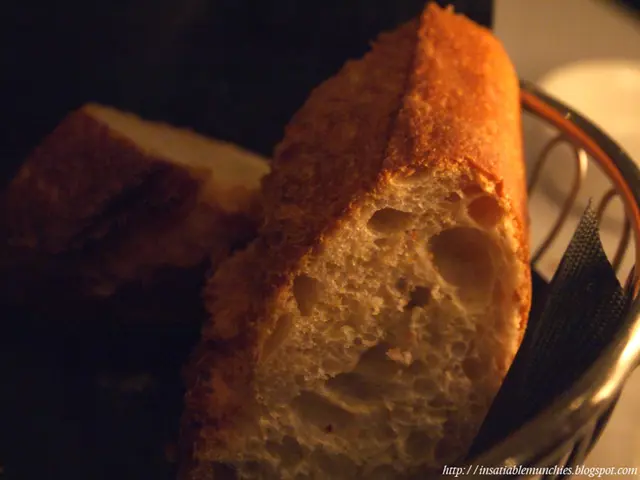DIY Water Kefir Recipe: A Simple Guide to Prepare Fermented Drink at Home
Make Your Radical Water Kefir at Home!
Are you ready to kickstart your fermentation journey? Water kefir is a fizzy, delicious, and probiotic-rich beverage that's easy to make at home! Here's your guide to diving into the world of water kefir.
Want to get straight to the point? Check out the Recipe Section. For those who crave more knowledge, read on to learn about water kefir's origins and distinguishing features from milk kefir.
What's the Dirt on Water Kefir?
Water Kefir:- Is a fermented, carbonated beverage produced by water kefir grains.- Derives from various parts of the globe, known by various names: water kefir, sugar kefir, tibicos, tibi, ginger beer plant, California bees, Tibetan mushroom, aqua kefir and Japanese beer seeds.- Is appreciated for its zesty taste and health benefits.
When Water Kefir Gets Wild and Crazy
Although sharing the name and starting culture, water kefir and milk kefir are completely different:- Milk kefir grains ferment animal milk to produce a tangy milk beverage.- Water kefir grains transform sugar water into a fizzy, dairy-free beverage.
If you're curious about the deets, check out our in-depth guide on differentiating water kefir and milk kefir.
Mastering Water Kefir: A 4-Step Journey
- Mix: Combine water, sugar, dried fruit (figs usually work best), kefir grains, and lemon.
- Ferment: Leave the mixture at room temperature for 24 to 72 hours.
- Flavor (optional): Infuse your water kefir with your preferred flavors, such as fresh fruit or herbs, after fermentation.
- Bottle: Transfer your water kefir to pressure-resistant bottles, and let it sit for another 24-48 hours for a bubbly and flavorful brew!
⚠️ Note: If you have dehydrated kefir grains, follow our guide to rehydrate them.
Setting the Scene: Ingredients for Water Kefir Success
- Water Kefir Grains: Live cultures for kickstarting fermentation.
- Water: Opt for chlorine-free, drink-worthy water that suits your fermentation needs.
- Sugar: In the range of 1/3 to 1/2 cup of sugar per litre of water. Prefer unrefined cane sugar.
- Dried Fruit: Dried figs are ideal, but dried apricots or raisins will also do the trick.
- Lemon: Enhances flavor and acidity, assisting with fermentation.
Equip Your Kit
No fancy equipment required! All you need is:
- A Wide-Mouthed Jar: Ideal for mixing and fermenting your water kefir.
- Fine Mesh Cloth: Secure over the jar to cover it during fermentation.
- Pressure Resistant Bottles: Use these for the second fermentation if you fancy fizzy water kefir. (Avoid Mason Jars!)
- Funnel with Filter: Makes the bottling process a breeze.
Psst! Check out the Kefirko Kit if you're after a one-stop solution for all your water kefir essentials.
The Recipe: Radical Water Kefir for a Revolutionary Palate
Preparation: 5 minutesTotal Time: 48 hoursServings: 1 Gallon (3.785 L) or 2–3 batches
Equipment
- 1 Kefirko Kit (large format)
- 2 pressure resistant glass bottles (750ml)
- 1 funnel with sieve
Ingredients
- 5 tbsp. water kefir grains
- 2/3 cup cane sugar
- 1 dried fig
- 2 tbsp. lemon juice
- 6 cups water
Instructions
Preparation
- Pour water into the jar.
- Add sugar and stir until dissolved.
- Add kefir grains, fig, and lemon juice.
- Fit a lid or fine mesh cloth on the jar.
Fermentation
- Allow the kefir to ferment at room temperature for 24 to 48 hours. Your fig will rise, and the kefir will acquire a tangy flavor and release fruity scents.
- Taste after 24 hours: If it tastes great, proceed to the next step. If not, extend the fermentation to 48 hours.
- Filter the kefir to remove the grains, figs, and lemon residue, leaving you with plain water kefir. Reserve the grains for your next batch and compost the fruit.
Flavoring (optional) - Add chopped fruit, fruit juices, herbal teas, or other flavors to your water kefir as desired.
Bottling - Using the funnel, pour the kefir into pressure-resistant bottles. - Store the bottles at room temperature for 24 to 48 hours to build up carbonation. - After 24 hours, open and close the bottles to check fizziness, and allow them to ferment longer if needed. - Once satisfied with the carbonation level, place the bottles in your fridge to slow down fermentation.
Remember: If you come across dehydrated kefir grains, activate them before getting down to business.
Storing Your Kefir Grains: The Right Way to Hang On
Don't get discouraged if your water kefir grains need a break! Here are some top-notch storage options:
- Immediate Use: Jump into another batch right away for healthy, thriving grains.
- Refrigeration: Store your grains in an airtight container with water and 1 tsp of sugar, then refrigerate for up to three weeks. Afterward, drain, and jump into a new batch.
- Dehydration: Dehydrate your grains at 40°C (104°F) for 24–48 hours with good air circulation, ensuring healthy microorganisms and reducing the risk of contamination.
- Freezing: Avoid freezing kefir grains, as it causes damage and makes them smaller and less efficient at fermentation.
Making Your Water Kefir Interesting: A Flavor Explosion
Plain water kefir is tasty, but it's even better when you get creative! Spiffy up your water kefir by adding fruit juices, herbal teas, chopped fruit, or other delectable add-ons. Just make sure to remove the grains before adding flavorings to avoid contamination.
Looking for inspiration? Take a gander at our guides on flavoring water kefir and exploring water kefir recipes.
FAQs: Frequently Asked Questions About Water Kefir
Recognizing a Successful Ferment: Munson's Maxim
Your water kefir is a success when it displays:- A tangy flavor.- Fizziness before bottling and an even more bubbly texture after bottling.
The Dried Fruit Dilemma: What to Use When Dried Figs Aren't an Option?
Yes, dried fruit provides necessary nutrients that kefir grains crave! Dried apricots and raisins are good alternatives. If you desire, use double the amount of figs when using an alternative.
A Sip Without Lemon: Going Rogue
Though lemons contribute to creating the proper acidity for fermentation, you can replace it with another citrus fruit juice, or pasteurized cider vinegar.
When No Figs Grace Your Counter: Finding Balance
Yes, it's possible to make water kefir without figs. To keep your grains healthy, offer them nutrient-rich water and use low-processed sugar options.
Mine Minerals, Fear Not: What Makes Them Important
Minerals play a vital role in the proper functioning of your water kefir, ensuring it ferments without a hitch and keeping your grains strong and thriving. Water, sugar, and dried fruit are all the sources you'll require for mineral provisions!
Much Kefir, Much Gains? How Much Can I Drink a Day?
The number of glasses of water kefir you can drink depends on your body and how it responds to new foods. Start with just one glass, then adjust to your liking. Though it has less sugar than juice or fizzy beverages, water kefir still offers a moderate amount of sweetness, so keep an eye on your consumption habits to maintain a balanced diet.
Healthy Kefir, Healthy Me: Explore the Science
Fascinated by the health benefits of water kefir? Check out the science behind water kefir.
Chance Encounters: The Risks of Water Kefir
Water kefir is generally safe when made with quality ingredients and clean equipment. For a deeper understanding of the risks and best practices, learn more about the potential health risks of water kefir.
How to Encourage Growth: Water Kefir's Growth Spurt
Water kefir grains grow and multiply when given the proper care and nutrition. To promote growth:- Make regular batches.- Maintain a consistent temperature (20 - 25°C or 68 - 77°F).- Provide appropriate nutrition without excessive or deficient minerals.- Limit prolonged refrigeration stays.
Milk Kefir, But Water Kefir Style: Experiments in Martha's Milky World
It's possible to make milk kefir with water kefir grains, but it's not recommended for extended use due to the differences in sugars and fermentation conditions.
Trying New Things: Experiments With Different Liquids
Yes, water kefir can be made with other liquids, but be prepared for the grains to weaken over time, especially if the nutrients in the liquid aren't tailored to their needs. Test new recipes using extra grains from your growing colony, preserving your base grains.
For the Milk-Free, Check Out These Alternatives
- Plant-Based Milk Kefir: Water kefir grains ferment coconut milk and soya milk beautifully. Coconut milk may thicken and acidify, while soya milk may not yield the best results.
- Coconut Water Kefir: For a uniquely tropical beverage, create a refreshing coconut and pineapple water kefir recipe.
- Apple Juice Kefir: Transform your apple juice into a bubbly, flavor-packed beverage by infusing it with kefir grains!
Understanding the Anatomy of Water Kefir Grains
Water Kefir grains are composed of bacteria, yeast, and polysaccharides, which provide the perfect gel habitat for the microorganisms that create delicious water kefir.
Now You're Squeaky Clean: What to Use Instead of Lemon Juice
Pasteurized cider vinegar or another citrus juice can take the place of lemon juice in water kefir recipes.
Choosing Ground Zero: Fermentation Spots
Ferment your water kefir at room temperature (20 - 25°C or 68 - 77°F) in a stable spot, away from direct sunlight, for optimal results.
War, Not Wine: Water Kefir Turned Vinegar
Though it's possible to produce water kefir vinegar, it's not advisable since it won't provide a high-quality, long-lasting vinegar due to the low alcohol content.
Alcohol, Not Booze: Reducing the Hooch in Your Homemade Hooch
Water kefir contains minimal alcohol (usually less than 2%). To decrease the alcohol content, you can modify the sugar, encourage aerobic fermentation, or allow the alcohol to evaporate by leaving the bottle open for a few hours, but the alcohol will always be present to some degree.
From Scratch beginning, or Starters Used: Growing Water Kefir Grains the Old-Fashioned Way
Though the origin of water kefir grains is unknown, they are not grown or made from scratch. If you wish to share your water kefir grains or you come across some, proper care ensures their continued production of delightful, fizzy beverages for generations to come!
Can I Eat My Kefir Grains?
While consuming water kefir grains is safe, their gelatinous texture and strong taste make them less than appetizing. Stick to sipping your water kefir and save your grains for making more of the probiotic potion everybody craves!
- Incorporate water kefir into your healthy lifestyle: Water kefir's beneficial bacteria and probiotics can complement your fitness-and-exercise routine and food-and-drink preferences, as part of a holistic health-and-wellness approach.
- Enjoy deliciously flavored water kefir: Let your culinary creativity shine by exploring various cooking techniques and infusions to create tantalizing, unique water kefir flavors, enhancing your lifestyle and food-and-drink choices.
- Join the fermentation revolution at home: Experimenting with home-made water kefir contributes to a sustainable, eco-friendly lifestyle, reducing your reliance on store-bought products, promoting cooking skills, and enhancing your understanding of science and fermentation processes.








